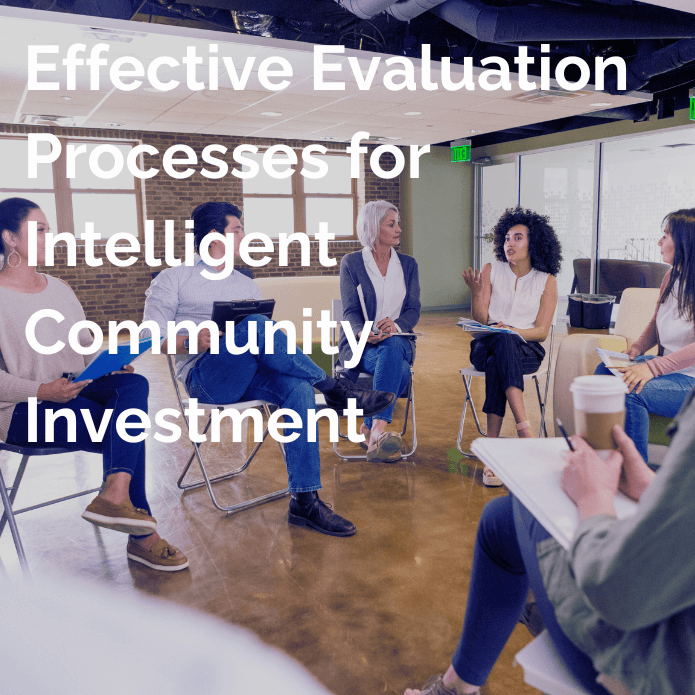Set up your grant evaluation for confident and clear impact investment
Your evaluation process is complete. The criteria were spot-on, the right people participated, and the scores pointed you to the right program investments to achieve your organization’s goals. YES! How did you get there?
Evaluating requests for funding can equate to tough decisions.
The good news? Your application set you and your volunteer reviewers up for success by collecting the right information. Now you can focus on the bigger question…
Will investing in this program help my organization achieve its goals?
Creating an evaluation process that makes answering this question easier is within reach!
Evaluation Criteria
At the end of the day, you want your evaluation results to be reliable. Develop criteria to be certain the scores you get out of your evaluation will give you a solid basis for making funding decisions that will contribute to your strategic plan objectives.
• Review your evaluation criteria through your strategic plan lens. Does it align with what your organization says it wants to accomplish?
• Identify the critical elements that must be shown in an application to determine the criteria each will be measured against (need to have vs. nice to have).
• Provide clear, succinct criteria and simple scoring options for your reviewers to help eliminate confusion and reduce variations in how reviewers are scoring.
Gather the Right People
Bringing the right people to the table will lead to strong evaluation results.
• If the funding opportunity is focused on a specialized community need, consider recruiting a specialized group of evaluators who are experts in the field.
• A community-wide call for proposals may need a diverse group of community volunteer reviewers.
• If volunteers need to have certain attributes, skills, or experience to meet your needs, consider a volunteer application.
• Some funding opportunities will have unique circumstances. Decide if your review should remain internal with your organization’s staff or Board of Directors.
Assign the Right People to the Right Place
Now that you have the right people, ensure you are utilizing their strengths so they feel good about their contribution and, just as importantly, you get solid recommendations to work from.
• If you have a financial review to ensure sound investment, recruit volunteers who have a finance background who are better qualified to discern the information in a budget, audit, and IRS Form 990.
• Find out what areas or priorities program reviewers are passionate about and assign them to review applications in that area.
• Collect conflict of interest information from all reviewers and ensure no reviewer (staff, board member, or volunteer) is assigned to review any applications where the integrity of the process may be called into question.
Educate to Evaluate
Informed reviewers are effective reviewers. Give them the training and information they need to give you a solid evaluation result.
• Offer an overview of your organization’s work, goals, and how programs should contribute to them.
• Provide tailored training based on your reviewer’s assignments, whether it be financial, program, or other unique evaluation type.
• Coach reviewers on how to score by providing an explanation of what each score means to you. For example, describe what would justify a rating of “Exceeds Expectations.”
Decisions Decisions
Reviewers have submitted their scores and recommendations and you’re ready to move on with the funding decision process. There are many paths you can take to facilitate the best possible funding decisions.
• Invite reviewers to a post-evaluation meeting to discuss their findings and concerns, ask questions, and affirm or update their recommendations and scores.
• Host in-person interviews with applicants and reviewers to receive additional information and/or clarification regarding their request.
• Schedule site visits to applicants’ locations to see program services firsthand.
• Determine if your organization’s staff will weigh in with their unique insight that reviewers may not have and if that insight will have any bearing on the final funding decisions.
• Establish what funds are available and how they will be allocated.
• Decide how you will handle allocations if highly-rated program requests exceed the amount of funds available. Will you fully fund those the highest rated programs or fund all qualified programs at a reduced amount?
Closing the Loop
Now that your funding decisions have been made, let’s wrap it all up with a nice, neat bow!
• Thank your reviewers! They shared their time and talent with you. It’s important to let them know much you appreciate their contribution.
• Share feedback with your applicants. Whether they receive funding or not, providing feedback to applicants will demonstrate that you value their effort and help them improve their future performance.
• Share the decisions with your community. Donors, volunteers, and community members are invested in the impact you make. Keep them informed to keep them engaged.
e-CImpact simplifies the evaluation process by keeping all application and review materials in one place, streamlining communication with reviewers, managing site visits, and allowing you to create evaluation reports in just a few clicks. All to create a seamless experience for you, your applicants, and your reviewers.
Learn how having e-CImpact in your community investment toolbox can help your organization efficiently and effectively accelerate your journey to creating effective evaluation processes by reaching out to the Seabrooks team at sales@seabrooks.com.
